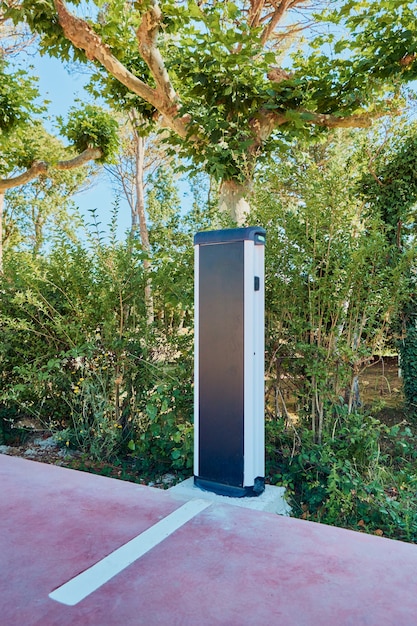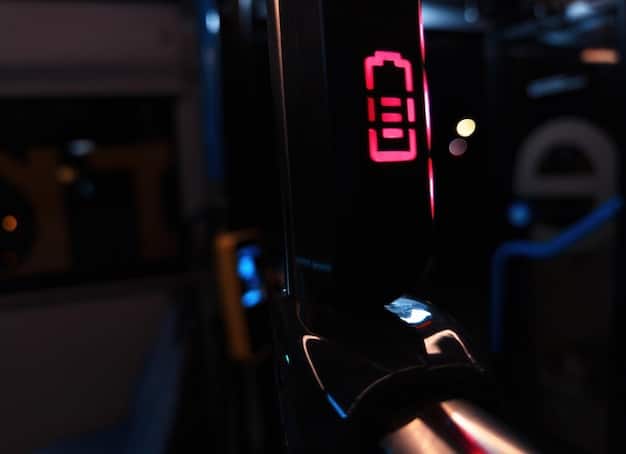Latest Innovations in US Electric Vehicle Charging Infrastructure

The latest innovations in US electric vehicle charging infrastructure include advancements in charging speeds, wireless charging technology, smart grid integration, and the expansion of charging networks across the country.
As electric vehicles (EVs) become increasingly popular across the United States, the demand for efficient and accessible charging infrastructure is soaring, leading to groundbreaking advancements; let’s explore what are the latest innovations in US electric vehicle charging infrastructure.
The Rise of Ultra-Fast Charging
One of the most significant advancements in EV charging is the development of ultra-fast charging technology. These charging stations dramatically reduce the amount of time it takes to charge an EV, making them more convenient for drivers, especially on long journeys.
Increased Charging Speeds
Ultra-fast charging stations can deliver up to 350kW of power, allowing EVs to gain up to 200 miles of range in about 30 minutes. This capability addresses one of the primary concerns of EV drivers: range anxiety.
Impact on EV Adoption
The availability of ultra-fast charging stations is expected to accelerate the adoption of EVs by making them a more practical option for daily use and long-distance travel. As these stations become more widespread, they will play a crucial role in supporting the growing EV market.
- Reduced charging times enhance convenience for EV owners.
- Higher power outputs enable faster energy transfer.
- Strategic placement along major routes eases long-distance travel.
- Investment in robust infrastructure supports EV market growth.

The expansion of ultra-fast charging networks is crucial for the future of electric mobility. Companies are investing heavily in deploying these stations across the country, ensuring that EV drivers have access to reliable and rapid charging options wherever they go.
Wireless Charging Technology
Wireless charging technology is emerging as a convenient and hands-free solution for EV charging. This technology eliminates the need for cables and plugs, offering a seamless charging experience.
How Wireless Charging Works
Wireless charging uses resonant inductive coupling to transfer energy from a charging pad to a receiver in the EV. Drivers simply park their vehicle over the charging pad to initiate the charging process.
Benefits of Wireless Charging
Wireless charging offers numerous benefits, including increased convenience, reduced clutter, and potential for integration into public parking spaces and roadways. It also opens up possibilities for autonomous charging in self-driving EVs.
- Enhances user convenience through cable-free operation.
- Enables seamless integration into various parking and roadway environments.
- Supports autonomous charging for self-driving EVs.
- Minimizes physical wear and tear on charging components.
The development of wireless charging standards is crucial for ensuring interoperability between different vehicles and charging systems. Efforts are underway to establish common standards that will facilitate the widespread adoption of wireless charging technology.
Smart Grid Integration
Integrating EV charging infrastructure with the smart grid is essential for managing the increasing demand for electricity and ensuring grid stability. Smart grid technologies enable utilities to optimize energy distribution and reduce the strain on the grid.

Vehicle-to-Grid (V2G) Technology
V2G technology allows EVs to not only draw power from the grid but also to send power back to the grid when needed. This bidirectional energy flow can help stabilize the grid and provide ancillary services to utilities.
Benefits of Smart Grid Integration
Smart grid integration offers several benefits, including improved grid resilience, reduced energy costs, and increased use of renewable energy sources. It also enables utilities to better manage peak demand and avoid costly infrastructure upgrades.
- Enables bidirectional energy flow for grid stabilization.
- Optimizes energy distribution and reduces strain on the grid.
- Reduces energy costs through efficient energy management.
- Supports increased use of renewable energy sources.
Pilot projects are underway to test the feasibility of V2G technology and demonstrate its potential to support the grid. These projects are exploring different business models and use cases to determine the best way to deploy V2G technology on a large scale.
Expansion of Charging Networks
Expanding the availability of EV charging stations is crucial for supporting the growing number of EVs on the road. Governments and private companies are investing in the deployment of charging networks across the country, ensuring that EV drivers have access to charging options wherever they go.
Public Charging Infrastructure
Public charging stations are being installed in a variety of locations, including shopping centers, parking garages, highway rest stops, and workplaces. These stations provide convenient charging options for EV drivers on the go.
Government Initiatives and Incentives
Federal, state, and local governments are offering incentives and funding to support the deployment of EV charging infrastructure. These initiatives include tax credits, grants, and rebates for the purchase and installation of charging stations.
- Strategic placement in public spaces increases accessibility.
- Government incentives lower installation costs.
- Partnerships between public and private sectors drive expansion.
- Standardization efforts improve network interoperability.
The development of charging standards is essential for ensuring that different vehicles and charging systems can work together seamlessly. Efforts are underway to establish common standards that will facilitate the widespread adoption of EV charging technology.
Standardization of Charging Protocols
Establishing uniform standards for charging protocols is vital for ensuring compatibility and convenience across different EV models and charging networks. Standardization promotes a seamless experience for EV drivers, regardless of the charging station they use.
The Combined Charging System (CCS)
CCS is emerging as a dominant charging standard in the US, supporting both Level 2 AC charging and DC fast charging. This versatility makes it a popular choice among EV manufacturers and charging network operators.
Benefits of Standardized Protocols
Standardized protocols offer numerous benefits, including reduced complexity for manufacturers, improved interoperability for drivers, and lower costs for charging network operators. They also facilitate the development of advanced charging features and services.
- Ensures compatibility across different EV models.
- Simplifies manufacturing processes for EV and charger producers.
- Reduces costs for charging infrastructure development and maintenance.
- Facilitates the integration of advanced charging functionalities.
Ongoing efforts to refine and expand charging standards are focused on addressing emerging challenges, such as high-power charging and wireless charging. These efforts aim to ensure that charging infrastructure can keep pace with the evolving needs of the EV market.
Future Trends in EV Charging
The future of EV charging is expected to be shaped by several emerging trends, including the integration of renewable energy sources, the development of mobile charging solutions, and the deployment of smart charging management systems.
Renewable Energy Integration
Integrating solar and wind power directly into EV charging stations can reduce the carbon footprint of EV charging and lower energy costs. This approach aligns with the growing emphasis on sustainability and decarbonization.
Mobile Charging Solutions
Mobile charging services offer on-demand charging for EVs in remote locations or during emergencies. These services use mobile charging units to deliver power to EVs wherever they are needed.
- Reduces the carbon footprint of EV charging operations.
- Provides convenient charging options in remote locations.
- Optimizes energy consumption based on real-time data.
- Enhances grid stability through smart energy management.
The deployment of smart charging management systems is expected to play a key role in optimizing energy consumption and reducing the strain on the grid. These systems use real-time data and advanced algorithms to manage charging schedules and minimize peak demand.
| Key Point | Brief Description |
|---|---|
| ⚡Ultra-Fast Charging | Speeds up charging, adding 200 miles in 30 minutes. |
| 🖐️Wireless Charging | Cable-free charging using resonant inductive coupling. |
| 💡Smart Grid Integration | Optimizes energy distribution, ensuring grid stability. |
| 🌐Charging Network Expansion | Increases station availability in public spaces. |
FAQ
▼
Ultra-fast charging is a method that provides high-power electricity, allowing EVs to charge much faster than traditional methods. It can deliver up to 350kW, significantly reducing charging times.
▼
Wireless charging uses resonant inductive coupling. A charging pad transfers energy to a receiver in the EV when the vehicle is parked over it, eliminating the need for cables.
▼
V2G technology allows EVs to both draw power from and send power back to the electrical grid. This helps stabilize the grid and can provide ancillary services to utilities.
▼
Smart grid integration improves grid resilience, reduces energy costs, and increases the use of renewable energy. It enables utilities to manage demand and avoid costly upgrades.
▼
Standardization ensures compatibility and convenience across different EV models and charging networks, offering a seamless charging experience. It also reduces complexity and costs.
Conclusion
As the electric vehicle market continues to expand, the ongoing innovations in charging infrastructure are paving the way for a more sustainable and convenient transportation future. From ultra-fast charging to smart grid integration, these advancements are addressing key challenges and accelerating the adoption of EVs across the United States.





